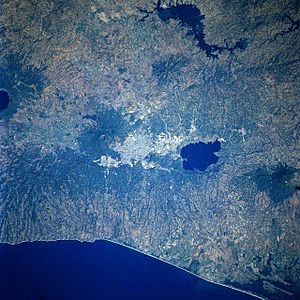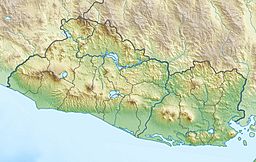Cerrón Grande Reservoir facts for kids
Quick facts for kids Cerrón Grande Reservoir |
|
|---|---|
| Lake Suchitlán | |

View of the reservoir from Suchitoto
|
|
| Location | El Salvador, Central America |
| Coordinates | 14°00′00″N 89°01′50″W / 14.00000°N 89.03056°W |
| Type | Artificial lake |
| Native name | |
| Etymology | Nahuatl for "Place of Flowers" (for Suchitlán) |
| Primary inflows | Acelhuate River, Lempa River |
| Primary outflows | Lempa River |
| First flooded | 1976 |
| Max. length | 40 km (25 mi) |
| Max. width | 10 km (6.2 mi) |
| Surface area | 135 km2 (52 sq mi) |
| Average depth | 30 m (98 ft) |
| Max. depth | 56 m (184 ft) |
| Water volume | 2,150 km3 (520 cu mi) |
| Surface elevation | 230 m (750 ft) |
| Settlements | Colima, Platanares, San Cristobal, San Francisco Lempa, San Juan, San Luis del Carmen |
The Cerrón Grande Reservoir, also known as Lake Suchitlán, is the largest body of fresh water in El Salvador. It is an artificial lake created between 1973 and 1976. This happened after the Cerrón Grande Hydroelectric Dam was built. Even though it's a beautiful place, the Cerrón Grande Reservoir is one of the most polluted fresh water bodies in Central America.
Contents
What's in a Name?
The reservoir gets its name, Cerrón Grande, from the hydroelectric dam that created it. The dam itself was named after the land it was built on.
Locally, people often call it Lake Suchitlán (Lago Suchitlán). The word "Suchitlán" comes from the Nahuatl language. It means "Place of Flowers." This name was given to the lake by a Salvadoran writer named Alejandro Coto.
Where is the Cerrón Grande Reservoir?

The Cerrón Grande Reservoir is located in northern El Salvador. It is surrounded by four different areas called departments: Cabañas, Chalatenango, Cuscatlán, and San Salvador.
Two main rivers flow into the reservoir: the Acelhuate River and the Lempa River. The Lempa River is also the main river that flows out of the reservoir. It travels from the northwest to the southeast.
The reservoir covers a huge area of 135 square kilometers (about 52 square miles). This makes it the biggest body of water in El Salvador. The Lempa River flows out of the reservoir at about 153 cubic metres (5,400 cu ft) per second.
Nature and Fun Activities
The Cerrón Grande Reservoir is home to many different kinds of plants and animals. It has twelve of the fourteen types of fish native to El Salvador. You can also find many bird and plant species here. Because of all this wildlife, it's a popular spot for tourists.
In 2005, the reservoir area was named part of the Cerrón Grande Wetland. This was done to help protect the animals and plants that live there. Popular activities at the reservoir include birdwatching, taking boat rides, and kayaking.
How the Reservoir Was Made
The construction of the Cerrón Grande Hydroelectric Dam began in 1973. It was started by President Arturo Armando Molina. By December 1976, the area behind the dam was completely filled with water, creating the reservoir. The dam helps produce electricity, with a power output of 135 kilowatts.
When the area was flooded, several villages, farms, and important historical sites of the Lenca people were covered by water. About 12,000 people had to move from their homes. Another 9,000 people were also relocated. A main road connecting Chalatenango to El Coyolito was flooded and had to be rebuilt. Also, direct travel between Chalatenango and Suchitoto was no longer possible.
Environmental Concerns
The Cerrón Grande Reservoir faces serious environmental challenges. Experts say it is one of the most polluted fresh water bodies in Central America. Studies have found high levels of harmful substances in the water. These include heavy metals, certain chemicals, and bacteria. These pollutants can harm the health of people and animals living near the reservoir.
A lot of waste from San Salvador flows into the reservoir through the Acelhuate River. Since it was created, the reservoir has become a "hypertrophic lake." This means it has too many nutrients, which can lead to low oxygen levels in the water and poor water quality. Harmful substances have been found in the reservoir's waters.
Also, a lot of sedimentation is happening in the reservoir. Sedimentation is when soil and dirt build up at the bottom of the lake. This is largely caused by deforestation (when many trees are cut down). Experts estimate that about 7 million cubic meters (247 million cubic feet) of sediment build up each year.
Gallery
See also
 In Spanish: Lago Suchitlán para niños
In Spanish: Lago Suchitlán para niños
- Canton El Tablon – a town in Cuscatlán that was flooded by the reservoir
- Lake Ilopango – El Salvador's largest natural lake








